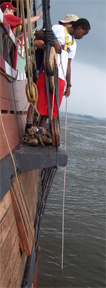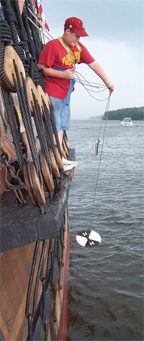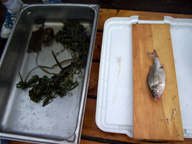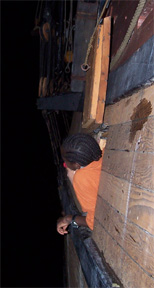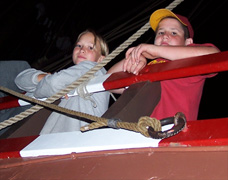 |
||
|
Saturday September 17, 2005 |
||
Morning Position |
Midday Position Athens Channel 42˚ 16.2 minutes latitude 073˚ 48.0 minutes longitude |
Evening Position Athens Channel 42˚ 16.2 minutes latitude 073˚ 48.0 minutes longitude |
0700 hours: The Half Moon crew rises to greet a new dawn. On this day in 1609, Hudson and his crew had repeated trouble with running aground while maneuvering through these uncharted waters. No such troubles for us; we'll be staying at anchor all day. The weather has turned cool and comfortable, punctuated only by light shower passing over us in mid-afternoon. We have a guest this morning: Michael Black, of Liberty Paint and Glenco Construction, who donated all of the paints we use aboard the Half Moon. After joining us for breakfast, Mr. Black invites a few of our adult crew to accompany him to his workshop in Athens. Our potable water supply is also running low, so we have the departing crew members take empty some water bottles with them. |
||
1015: The crew returns with replenished water supplies. In the meantime, Mr. Morel has used lengths of line found on the ship to create a small cargo net. We will use this net and tackles to stow our new supplies on board, just as Henry Hudson's crew would have done. To the right, Madena shows off her muscles as she single-handedly hauls the 60-pound bottles aboard. (She does get a little help from the mechanical advantage of the tackles, which cuts each bottle's effective weight to 20 pounds.) |
||
1030: The entire crew is now back on board, and the students turn their full attention to their academic projects. Staying at our current anchorage gives our student crew members all the time they need for their experiments. Having started their projects yesterday, the students continue gathering data throughout the day. By mid-afternoon, after the students have tracked their specific topics over a full 24-hour period, they gradually start turning their attention to compiling their findings for their final reports. |
||
Above left:Meaghan uses a quadrant to track the position of the sun. Center: Adam checks the readings of the photovoltaic cell he's mounted above the helm hutch. Right: Shannon tosses a wooden chip into Athens Channel to measure the speed of the water current. |
||
Richard spends most of his day on the port channel, taking soundings with a lead line. He and Mr. Terry have decided to move here after finding the beak too cramped a workspace for their needs. |
||
Above left: Katie performs another complex tritration test to measure dissolved oxygen levels. Center: Kathleen pulls a Van Dorn sampler up from the water. She can submerge this device to trap water at the depths of her choice, then measure its temperature (or oxygen levels, for Katie's experiments) once she retrieves the sampler. Above right: Keith lowers the secchi disk to the water line to take a clarity reading. |
||
Riki also keeps a sharp eye out all day for the local avian wildlife. The list of birds she spots, catalogs, and illustrates include those pictured to the right. |
||
1230: Everyone takes a quick break for lunch. Then it's back to work!
1530: While the students are busy working, Mrs. Lawler takes advantage of her window of opportunity between lunch and dinner to fulfill a personal goal: To climb the shrouds all the way to the main mast top. After taking her harness test, she's up in a flash. To the right, Mrs. Lawler climbs skyward, accompanied by Mr. Morel and Meaghan. Meaghan also found the shrouds intimidating at first, but has obviously overcome her anxiety. |
||
Throughout the day, Mr. Dawson takes groups of students in twos or threes on exploratory trips in the Zodiac, accompanied by a second adult. These Zodiac trips are certainly exciting, but they also give the students their only opportunity away from port to look back from the river and see the Half Moon in its full glory. The students aren't just sightseeing, however. While out and about, they can collect specimens from the surrounding wetlands for study back on the ship. |
||
The first group of students out this morning visits the large sandbar that separates Athens Channel from the main course of the Hudson River. This sandbar is home to a variety of wildlife and has also been a popular local campsite for generations. The rest of the students visit the nearby creek and Sleepy Hollow Lake. |
||
While touring of the water, each student can also get a close look at the scenic lighthouse marking the channel's southern entrance. |
||
1700: A major discovery! Only just now, we have discovered a stowaway on board! When the first Zodiac expedition visited the sandbar this morning, they collected numerous wetland plant samples. Somehow, this tiny turtle went unnoticed and was accidentally scooped up along with the plants he was hiding among. Based on his tiny size, we assume that he is a recent hatchling. However, as a reptile, he's a miniature version of an adult. This makes is it easy to identify this hatchling's species: an alligator snapping turtle. When this hatchling is full grown, he could well be larger than the entire pan in which he currently resides. He's cute now, but once he grows up, you won't want him anywhere near your fingers. We quickly prepare a habitat for the turtle hatchling, using a scientific specimen pan and rocks, weeds, and water drawn from the river. The hatchling shelters himself under the largest rock -- by which he is well camouflaged -- and seems content for the moment. |
||
The turtle's next door neighbor isn't quite so lucky. Mr. Dawson, an avid fisherman, caught a perch this morning. We will now take this opportunity to dissect it. To the right, Mr. Prime handles the dissection duties, surrounded by curious students and his handy assistant Kyle. Move your mouse over the photo to the right if you would like a closer look at the dissection in progress. We offer a section of the fish to the turtle hatchling, who eventually chomps down a few bites before scurrying back to the protection of his weeds. Shortly before sunset, we return the turtle to the wetlands, releasing him roughly at the same spot we found him. We last see him heading for the trees and hope to encounter him again someday. |
||
1830: As the sun sets, we enjoy a hearty dinner of pork, potatoes, sweet potatoes, and carrots. |
||
1930: The student crew members gather on the orlop deck and focus on charting and compiling their data. |
||
Everywhere we look, students are busily analyzing and comparing their findings in preparation for their final presentations tomorrow. |
||
2100: Richard looks out a gun port and notices a fireworks display visible over the western horizon. We all hustle on deck to enjoy the show. We eventually determine that the fireworks are going off somewhere near (if not on) Lake Sleepy Hollow, though we don't know the cause for celebration. Onboard the Half Moon, however, it might as well be to congratulate our students for completing their academic projects.
|
||
2130: After the fireworks display concludes its grand finale, the students return to the orlop deck to update their journals and settle in for the night. 2200: We hold a brief anchor watch meeting (since we haven't moved since last night, everyone already knows what to look for). Then it's lights out and time for some well-earned sleep. |
||
On this date in 1609: The seventeenth, faire Sun-shining weather, and very hot. In the morning as soone as the Sun was up, we set sayle, and ran up sixe leagues higher, and found shoalds in the middle of the channell, and small Ilands, but seven fathoms water on both sides. Toward night we borrowed so neere the shoare, that we grounded: se we layed out our small anchor, and heaved off againe. Then we borrowed on the banke in the channell, and came aground againe; while the floud ran we heaved off againe, and anchored all night. -- Robert Juet's Journal.
|
||
